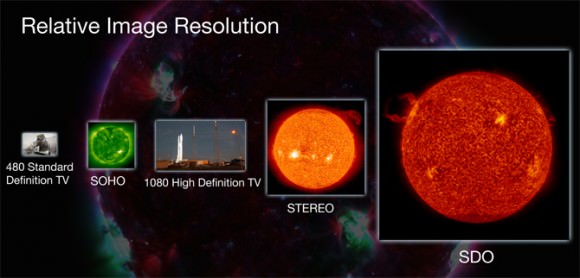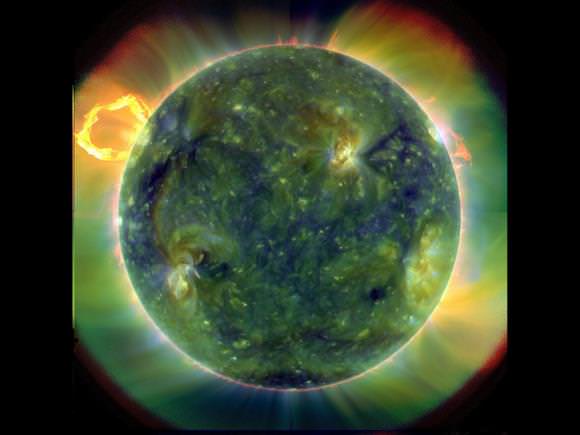[/caption]
NASA’s newest solar satellite is officially open for business and all we can say is, “Wow!” The Solar Dynamics Observatory (SDO) released its “first light’ images on Wednesday, showing incredible views of the sun, with extreme close-ups, never-before-seen detail of material streaming outward from sunspots and high-resolution looks at solar flares across a wide range of ultraviolet wavelength.
“These initial images show a dynamic sun that I had never seen in more than 40 years of solar research,” said Richard Fisher, director of the Heliophysics Division at NASA. “SDO will change our understanding of the sun and its processes, which affect our lives and society. This mission will have a huge impact on science, similar to the impact of the Hubble Space Telescope on modern astrophysics.”
SDO launched in February and has been billed as the “Crown Jewel” of NASA’s fleet of solar observatories. This technologically advanced spacecraft is able to take images of the sun every 0.75 seconds and daily send back about 1.5 terabytes of data to Earth — the equivalent of downloading 380 full-length movies every day. The following graphic compares the capabilities of SDO with other missions and resolutions.

Serendipitously, shortly after the instruments opened their doors, our recently quiet Sun began to get a little more active. The video below was created from data from the Atmospheric Imaging Assembly, a group of four telescopes designed to photograph the sun’s surface and atmosphere. This data is from March 30, 2010, showing a wavelength band that is centered around 304. This extreme ultraviolet emission line is from singly ionized Helium, or He II, and corresponds to a temperature of about 50,000 degrees Celsius.
This movie captures only a fraction of SDO’s imaging capabilities. It shows the Sun’s magnetic field followed by only four of SDO’s 12 imaging wavebands. You’ll see an eruption, flare, and dimming (dark regions evacuated by the eruption) by observing the event in several different layers of the atmosphere. If you’re wondering why the movie doesn’t show all 12 layers at full resolution it’s because at high-res the movie would be nearly a third of a gigabyte in size.
The Helioseismic and Magnetic Imager maps solar magnetic fields and looks beneath the sun’s opaque surface. HMI was undergoing a series of adjustments when it captured an eclipse of sorts. SDO’s view was partially blocked by the Earth. At the edges of the shadow, the Sun’s shape bends, due to the light’s refraction by the Earth’s atmosphere. SDO will have two “eclipse seasons” each year, when the orbit of SDO will intersect the Sun-Earth line.
For more images and a high-res version of the top image, see the SDO website.
Just remember — this is only the beginning of SDO’s mission!
Source: NASA


Absolutely stunning images! Its not often one can see with one’s own eyes the beginning of a whole new solar physics paradigm! Go SDO! ~*~
Hey Nancy.
Awesome article, just one wee niggle though.
You wrote:
I might be a little rusty, but wouldn’t Singly ionized Helium (Para 4, Sentence 4) be He(I) with He(II) being doubly ionized Helium?
Hey, Nancy…
At the fifth paragraph, last sentence:
There’s a missing apostrophe in “its”, and a missing “be” as shown.
Hey, Trippy…
The statement in the paragraph that you referred to is correct: singly ionized (one of two electrons missing) helium is He II; doubly ionized (alpha particle) helium is He III; whereas neutral helium is He I.
@IVAN3MAN
It turns out you’re righ, bizzarly (no offense intended)t. -_-
It’s bizzare because it runs completely contrary to the IUPAC Nomenclature of Inorganic Chemistry even though what you’re saying is backed up by the NIST He(II) Transition Table.
Under the IUPAC nomeclature (what I’m accustomed to using, and what I naturally assumed was being used) Neutral Helium would be He(0), Singly Ionized Helium would be He(I) and Doubly Ionized Helium would be He(II).
-_-
:Sigh:
Apparently I messed up my links.
IUPAC Nomenclature of Inorganic Chemistry
NIST He(II) Transition Table
Don’t worry Trippy, to astronomers anything more massive than helium and less so than the heaviest thing that ever will have existed is simply metal. You never had a chance 🙂
Hey IVAN3MAN,
Before correcting someones grammar you should ensure yours is correct.
1. Like many individuals you misuse the word, “that”. It should be removed from the sentence completely. You will notice your sentence is fine without it.
2. When creating a list of items after a colon they should be separated by a comma not a semi-colon.
Again… this is a BLOG; an informal means of communication. Leave your Grammar Police badge in your pocket.
Playing grammar police discourages the participation of individuals who may be worried about some ding-dong saying something about their writing. There are also those like me, where English is not their first language, and may not be proficient.
As long as you can understand what someone is saying, and / or whatever is incorrectly written doesn’t affect the content of the subject, let it go. Especially, when you have your own grammar demons to deal with.
The more we learn to understand the dynamics of how the sun works, the better we can harness it’s energy for a cleaner, kinder and more ethical future here on Earth.
Can’t wait to see the helio-seismically derived 3D interior maps in an animated sequence! ~NICE~
Who would have thought that a single sentence, so elementary in it’s structure, could be so wrong? Beautiful photos, thanks Nancy.
Aodhhan:
Hey, Aodhhan, I refer you to the “Usage note” section on the term that at Dictionary.com, where it states at the bottom:
So, it is “a stylistic option” that I often choose to use in my writing. So there!
Aodhhan:
>
Actually, a semicolon is a comma that has gone to college. 😉
@ William928,
That should be its structure, not “it’s”. 🙂
HeII, metals, baryonic, forbidden, …
And a key measurement system that is not only logarithmic (lots of those), but scales as the 2.5th power (ratio of 100 = difference of 5), and is backwards (bigger = smaller)!
Face it, astronomers are truly from another world …
iantresman:
There, fixed it for you! 😉
@IVAN3MAN_AT_LARGE: Thanks, I don’t usually make that error!
@ William928,
Don’t worry about it; it’s a common error! I’ve even pointed out to Dr. Phil “The Bad Astronomer” Plait making the same error on his blog, on a number of occasions!